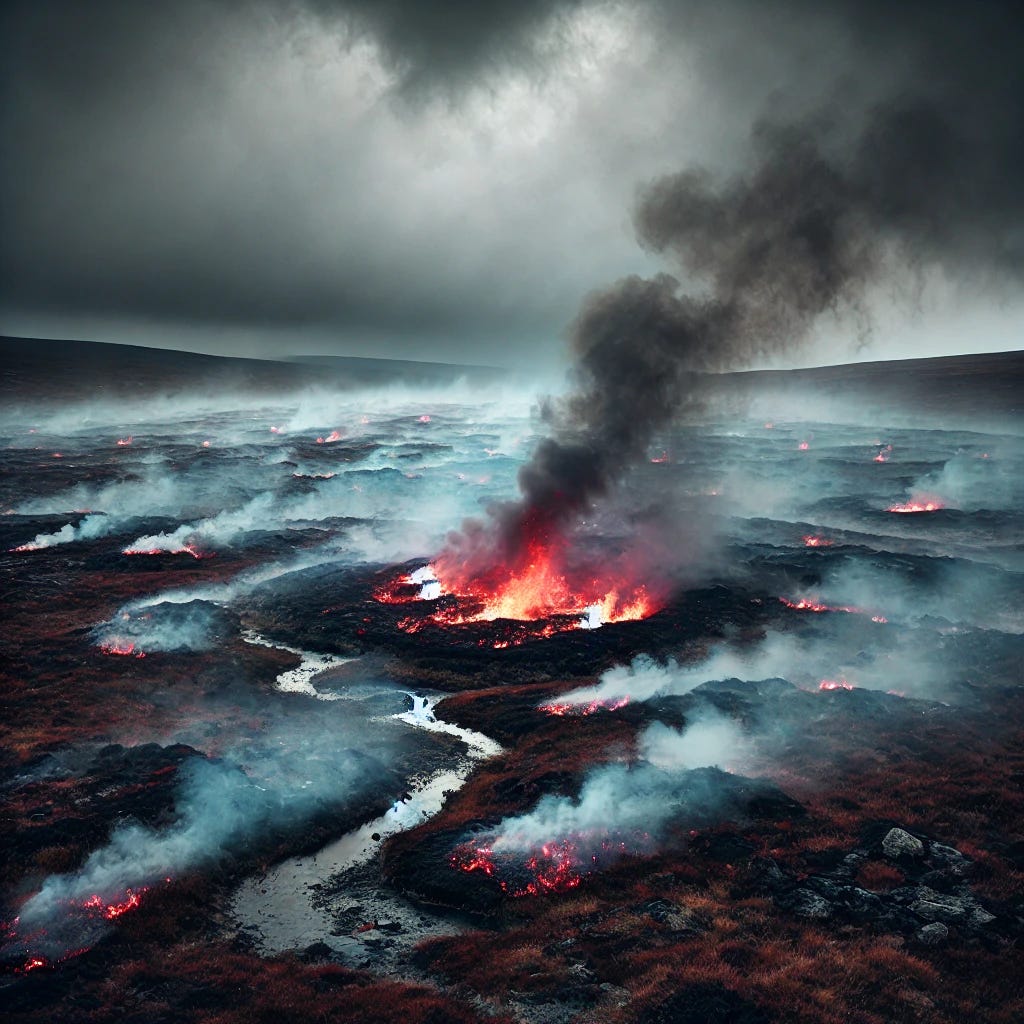Scotland’s natural landscapes have witnessed many extraordinary events, from legendary battles to supernatural tales. But few stories are as bizarre and fascinating as the Cochridge Moss Fire of 1826—a fire that smoldered beneath the earth’s surface for an entire year. This mysterious blaze, fueled by the very ground itself, became one of the longest-burning fires in Scottish history.
How did it start? Why did it burn for so long? And what does this strange event tell us about the land and its hidden dangers? Let’s dive into the remarkable story of the Cochridge Moss Fire.
The Summer That Set the Land Ablaze
The year 1826 was a remarkable one for Scotland—it was one of the driest years on record. A long, hot summer had parched the land, leaving even the dampest parts of the countryside vulnerable to fire. Peat bogs, which normally retained moisture and resisted flames, had dried out to an unusual degree.
It was in this dry and volatile environment that Cochridge Moss, a large peat bog in Blairgowrie, caught fire. The exact cause remains uncertain, but many believe it was accidentally started by a spark—perhaps from a careless passerby, a lightning strike, or even spontaneous combustion within the dried-out peat itself.
Whatever the cause, once the fire began, it refused to die. Unlike conventional fires that burn through grass, trees, or buildings, this blaze was fueled by peat, a dense, organic material formed from decomposed plant matter over thousands of years. Peat fires burn deep underground, making them incredibly difficult to extinguish.
A Fire That Wouldn’t Die
At first, the residents of Blairgowrie and the surrounding areas tried to combat the fire using traditional methods. They poured water over the flames, dug trenches to contain it, and even attempted to smother it with soil. But nothing seemed to work.
Unlike a surface fire, which can be doused with enough water, a peat fire burns from within, creeping slowly beneath the earth. The flames spread underground, moving invisible yet unstoppable beneath the surface. The fire consumed the rich layers of peat, hollowing out the ground as it burned. At times, the earth itself collapsed, creating deep holes where the fire had eaten away the foundation beneath.
Even when it seemed like the fire had finally died down, smoke would rise again from another part of the moss, signaling that the fire had merely migrated underground to another fuel source.
Days turned into weeks. Weeks turned into months. The fire refused to stop.
For an entire year, the Cochridge Moss burned.
The Impact on the Land and People
The prolonged fire transformed the landscape. What was once a thriving mossland—rich in plant life and home to various wildlife—became a scorched and barren wasteland. The ground was unstable, with deep pits left behind where the fire had burned away the peat.
Farmers who had relied on the bog for turf and grazing land found it unusable. The thick smoke, which often hung low over the valley, caused breathing difficulties for both people and animals. Some claimed the air itself smelled of burning earth for months.
There were even rumors of supernatural explanations. Some locals believed the fire was a punishment for sins left unatoned, while others speculated that ancient spirits had been disturbed. Given Scotland’s long history of folklore, it’s not surprising that such beliefs took root.
Eventually, the arrival of autumn rains and winter snow in 1827 finally extinguished the fire. With no oxygen left to fuel it, the blaze slowly faded, leaving behind blackened earth and a landscape permanently changed.
Lessons from the Cochridge Moss Fire
The Cochridge Moss Fire serves as a powerful reminder of how fragile Scotland’s peatlands can be under the right conditions. Peat fires, though rare in such a damp country, are among the most persistent and destructive natural fires in the world.
Even today, peat fires remain a global environmental issue. In places like Indonesia and Siberia, similar fires can burn for years, releasing vast amounts of carbon dioxide into the atmosphere, contributing to climate change. The Cochridge Moss Fire was an early example of this phenomenon—a fire that smoldered for an entire year, hidden beneath the surface, refusing to be tamed.
Though nearly two centuries have passed since the great fire of 1826, the story remains a fascinating piece of Blairgowrie’s history. A fire that no one saw coming, a blaze that would not die, and a landscape forever marked by the year-long inferno beneath the moss.





